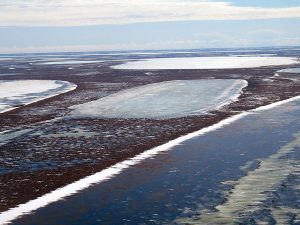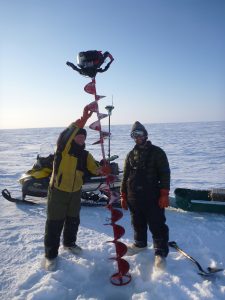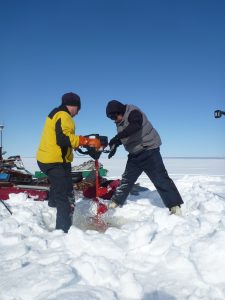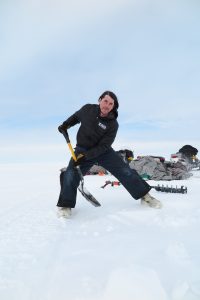16 June 2016
WASHINGTON, DC — New research shows permafrost below shallow Arctic lakes is thawing as a result of changing winter climate.

Shallow lakes on the Coastal Plain of Alaska. New research finds permafrost below shallow lakes such as these is thawing as a result of changing winter climate.
Credit: Christopher Arp, University of Alaska Fairbanks.
Warmer winters combined with an increase in snowfall during the last 30 years have limited the growth of seasonal lake ice. In response, lakebed temperatures of Arctic lakes less than 1 meter (3 feet) deep have warmed by 2.4 degrees Celsius (4.3 degrees Fahrenheit) during the past three decades, and during five of the last seven years, the mean annual lakebed temperature has been above freezing.
These rates of warming are similar to those observed in terrestrial permafrost, yet those soils are still well below freezing and thaw is not expected for at least another 70 years. However, a regime shift in lake ice is leading to sub-lake permafrost thaw now.

Chris Arp, lead author of the new study (left), and Ben Gaglioti of UAF (right) hold a drill bit used to take samples of permafrost.
Credit: Guido Grosse, Alfred Wegener Institute.
Since permafrost underneath lakes is generally warmer than the surrounding terrestrial permafrost, rising temperatures in the lakebeds make permafrost thaw sooner than beneath surrounding dry land. These lakes may cover 20 to 40 percent of the landscape in vast areas of Arctic lowlands.
“During the 1970s, late winter lake ice thickness measurements commonly exceeded 2 meters (6.5 feet) in northern Alaska. Such thick ice growth helps to limit sub-lake permafrost thaw by freezing the sediments solid each winter. However, during winter field surveys over the last decade, lake ice has typically only grown to 1.5 meters (5 feet) thick, and has been as thin as 1.2 meters (4 feet),” said Christopher Arp, research assistant professor at the University of Alaska Fairbanks (UAF) Water and Environmental Research Center and lead author of the new study accepted for publication in Geophysical Research Letters, a journal of the American Geophysical Union.

Chris Arp (left) and Ben Jones (right) drill into the ice of a shallow lake on Alaska’s North Slope.
Credit: Guido Grosse, Alfred Wegener Institute.
These drastic reductions in lake ice, caused by changes in winter climate, are the primary reason that shallow lakebed temperatures are warming and the permafrost below them is thawing.
Interactions and feedbacks among climate, permafrost, and hydrology underscore the complexity of forecasting change in the Arctic. For example, thinner lake ice may help fish overwintering, or it may help the oil industry since they need lake water to build winter ice roads. However, sub-lake permafrost thaw will likely unlock a portion of the permafrost carbon pool and potentially release this carbon in the form of greenhouse gases.
These findings also highlight the importance of conducting winter fieldwork in the Arctic.

Ben Jones, co-author of the new study, shoveling snow off of a lake before drilling a hole in the ice.
Credit: Christopher Arp, University of Alaska Fairbanks.
“Arctic lakes and ponds are typically ice covered for nine months of the year, but research on them typically occurs during the short Arctic summer. To more fully understand Arctic lake dynamics and to document the changes we have observed requires also doing fieldwork under often harsh conditions during the cold and dark arctic winter,” said Benjamin Jones of the U.S. Geological Survey in Anchorage and co-author of the new study.
“With further thawing of sub-lake permafrost there is a good chance that the ground will subside, increasing the lake depth and accelerating further permafrost thawing. In contrast, the warming on the land may increase the protective vegetation layer and delay thawing of permafrost outside of lakes,” said Vladimir Romanovsky of the UAF Geophysical Institute and co-author of the new study.
With increasingly warmer and snowier winters yielding thinner lake ice, shallow lakes will likely continue to warm, Arp said.
###
The American Geophysical Union is dedicated to advancing the Earth and space sciences for the benefit of humanity through its scholarly publications, conferences, and outreach programs. AGU is a not-for-profit, professional, scientific organization representing more than 60,000 members in 139 countries. Join the conversation on Facebook, Twitter, YouTube, and our other social media channels.
Notes for Journalists
This research article will be freely available for 30 days from the date of publication. A PDF copy of the article can be downloaded at the following link: http://onlinelibrary.wiley.com/doi/10.1002/2016GL068506/pdf
After 30 days, journalists and public information officers (PIOs) of educational and scientific institutions who have registered with AGU can download a PDF copy of the article from the same link.
Journalists and PIOs may order a copy of the final paper by emailing a request to Lauren Lipuma at [email protected]
Please provide your name, the name of your publication, and your phone number.
Neither the paper nor this press release is under embargo.
“Threshold Sensitivity of Shallow Arctic Lakes and Sub-lake Permafrost to Changing Winter Climate”
Authors:
Christopher D. Arp: Water and Environmental Research Center, University of Alaska Fairbanks, Fairbanks, Alaska, USA;
Benjamin M. Jones: Alaska Science Center, U.S. Geological Survey, Anchorage, Alaska, USA;
Guido Grosse: Alfred Wegener Institute Helmholtz Centre for Polar and Marine Research, Potsdam, Germany;
Allen C. Bondurant: Water and Environmental Research Center, University of Alaska Fairbanks, Fairbanks, Alaska, USA;
Vladimir E. Romanovsky: Geophysical Institute, University of Alaska Fairbanks, Fairbanks, Alaska, USA;
Kenneth M. Hinkel: Department of Geography, University of Cincinnati, Cincinnati, Ohio, USA;
Andrew D. Parsekian: Department of Geology and Geophysics, University of Wyoming, Laramie, Wyoming, USA.
Contact Information for the Authors:
Christopher Arp: +1 (907) 474-2783, [email protected]
Vladimir Romanovsky: +1 (907) 474-7459, [email protected];
Benjamin Jones: +1 (907) 786-7033, [email protected]
Lauren Lipuma
+1 (202) 777-7396
[email protected]
University of Alaska Contact:
Sue Mitchell
+1 (907) 474-5823
[email protected]
USGS Contact:
Yvette Gillies
+1 (907) 786-7039
[email protected]